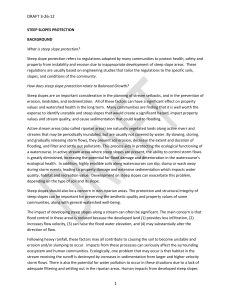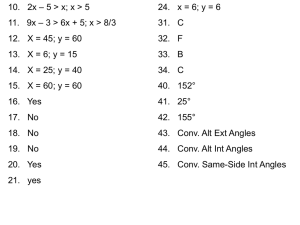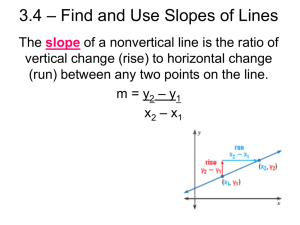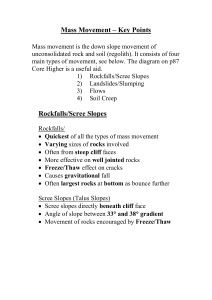Steep Slopes_BLLUP - Cleveland State University
advertisement
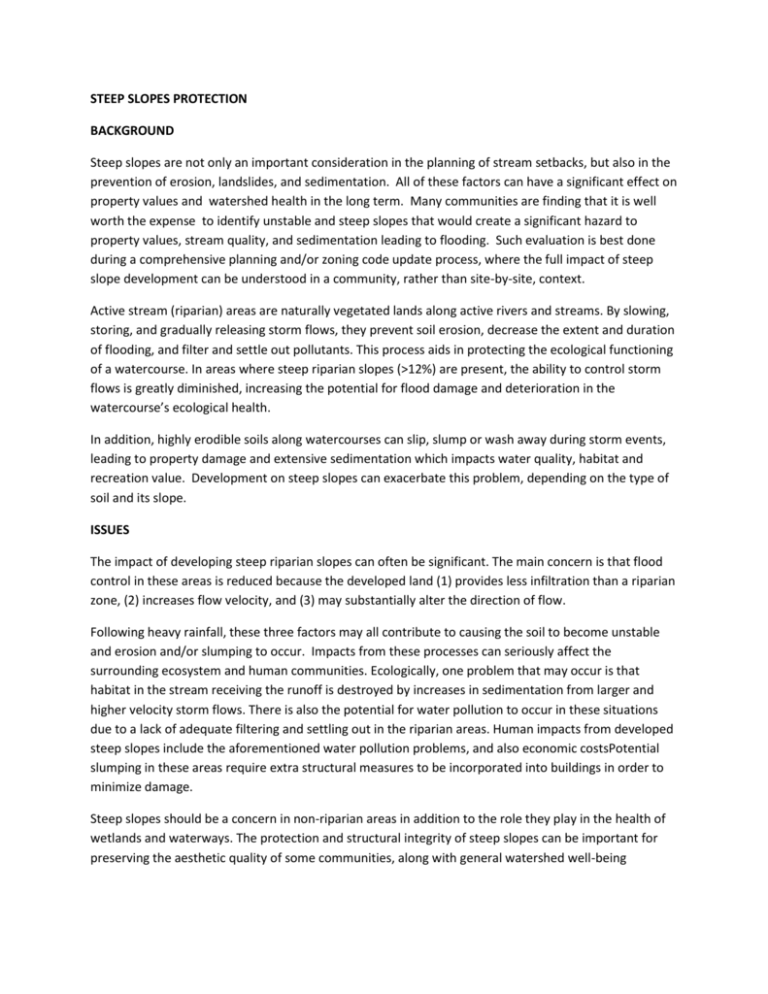
STEEP SLOPES PROTECTION BACKGROUND Steep slopes are not only an important consideration in the planning of stream setbacks, but also in the prevention of erosion, landslides, and sedimentation. All of these factors can have a significant effect on property values and watershed health in the long term. Many communities are finding that it is well worth the expense to identify unstable and steep slopes that would create a significant hazard to property values, stream quality, and sedimentation leading to flooding. Such evaluation is best done during a comprehensive planning and/or zoning code update process, where the full impact of steep slope development can be understood in a community, rather than site-by-site, context. Active stream (riparian) areas are naturally vegetated lands along active rivers and streams. By slowing, storing, and gradually releasing storm flows, they prevent soil erosion, decrease the extent and duration of flooding, and filter and settle out pollutants. This process aids in protecting the ecological functioning of a watercourse. In areas where steep riparian slopes (>12%) are present, the ability to control storm flows is greatly diminished, increasing the potential for flood damage and deterioration in the watercourse’s ecological health. In addition, highly erodible soils along watercourses can slip, slump or wash away during storm events, leading to property damage and extensive sedimentation which impacts water quality, habitat and recreation value. Development on steep slopes can exacerbate this problem, depending on the type of soil and its slope. ISSUES The impact of developing steep riparian slopes can often be significant. The main concern is that flood control in these areas is reduced because the developed land (1) provides less infiltration than a riparian zone, (2) increases flow velocity, and (3) may substantially alter the direction of flow. Following heavy rainfall, these three factors may all contribute to causing the soil to become unstable and erosion and/or slumping to occur. Impacts from these processes can seriously affect the surrounding ecosystem and human communities. Ecologically, one problem that may occur is that habitat in the stream receiving the runoff is destroyed by increases in sedimentation from larger and higher velocity storm flows. There is also the potential for water pollution to occur in these situations due to a lack of adequate filtering and settling out in the riparian areas. Human impacts from developed steep slopes include the aforementioned water pollution problems, and also economic costsPotential slumping in these areas require extra structural measures to be incorporated into buildings in order to minimize damage. Steep slopes should be a concern in non-riparian areas in addition to the role they play in the health of wetlands and waterways. The protection and structural integrity of steep slopes can be important for preserving the aesthetic quality of some communities, along with general watershed well-being The threshold of instability on a slope is highly variable and dependent on the soil type, vegetation, length and age of the slope. The possible impact of erodible slopes is also variable depending on the type of development proposed. A picnic shelter or trail, for example, may be far less impacting on a slope, and less susceptible to damage, than a house foundation.In some soils, the “no-build” threshold may be 20% (ratio of height to width of the slope); in some soils it may be 12%. It is important for communities with potential steep slope conditions to have them assessed by a qualified professional engineer as part of a comprehensive plan process, and/or build requirements for such assessments into development regulations, so that appropriate recommendations can be made for protection. RECOMMENDATIONS The development of areas containing steep slopes should generally be discouraged due to the issues given previously. Conservation and redevelopment of landscaped slopes should be a high priority for soil and sediment erosion control. Keeping a variety of native plants is much more effective than monocultures due to the layers of vegetation that offer higher levels of protection. In situations where conservation is not feasible, development should be done with the intent of minimizing soil disturbances, maximizing retention of trees and vegetation, and complementing steep slope character. In addition, the following three options can assist in establishing riparian setback widths that provide the same watercourse protection as flatter areas. Option 1: Permit Based Hillside Protection Zones. Regulations are passed that limit development activity in areas with slopes between appropriate percentage slopes (for example, between 15% and 30%). In order for permits to be given for disturbances in these areas, additional information including topographic maps, grading and site plans, geotechnical reports, details on future and present site stability, and an erosion and sediment control plan must be submitted for review. Following this review, the Building Inspector issues permits based on conditions set forth by the Planning Commission. Some activities such as driveways on slopes greater than 10%, embankments above 33%, and excavations above 40% are prohibited, as are projects that may endanger public health, safety, or welfare. Option 2: Expansion of Stream Setback for % Slope For many communities in the nation, minimum widths are usually established for Stream setbacks. In areas in which steep slopes exist within the designated stream setbacks, these widths are expanded. The expansions to the original widths are as follows: Add 10 feet for slopes between 15-17% Add 30 feet for slopes between 18-20% Add 50 feet for slopes between 21-23% Add 60 feet for slopes between 24-25% Option 3: Expansion of Stream Setbacks Based on Analysis of Slope, Slope Length, Soil Erodibility and Existing Vegetation. Stream setbacks are adjusted where steep slopes, 10% or greater, exist within 500 feet of a watercourse. In these areas, a plan is required that details information regarding the degree of sloping, the slope length, soil erodibility, vegetative cover, and sediment delivery. For each of these evaluation criteria, a score is given. The recommended percentages should be determined by professional engineering analysis. The following table provides an example. For areas with a score of 35 or greater, no development is allowed to take place. Scores of 25 and 30 require additional protective measures in order to be developed. Areas with a score of 20 or less can be developed with standard protective measures. Table 1. Evaluation Criteria for Steep Slopes and Erodible Soils Factors Scores High (10 points) Medium (5 points) Low (0 points) Slope (S) S ≥ 20% 10% < S < 20% S ≤ 10% Slope Length SL ≥ 200 feet 50 ft < SL < 200 ft SL ≤ 50 feet Soil Erodibility (K) K > 0.32 0.24 < K < 0.32 K < 0.24 Vegetative Cover Bare soil, fallow land, crops, active pasture in poor condition, orchard tree farm in poor condition Active pasture in fair condition, brush weeds in poor condition, orchard tree farm in fair condition, woods in poor condition Active pasture in good condition, undisturbed meadow, brush weeds in fair condition, orchard tree farm in good condition, woods in fair condition Sediment Delivery (distance from down slope limit of disturbance to outer edge of wetlands or top of stream bank) Adjacent to watercourses or wetlands (< 100 ft buffer) Adjacent to watercourses or wetlands (100 ft – 300 ft buffer) Not adjacent to watercourses or wetlands (> 300 ft buffer) Option 1 is the least recommended choice because it focuses mainly on structural integrity and not the functioning of the riparian area and watercourse. The recommendations given under this option may also not be appropriate for all areas of the watershed. Option 2 only focuses on the degree of sloping and does not take other important factors that play a role in riparian effectiveness into consideration. Option 3 provides the best alternative, as it based on site-specific conditions and recommendations. EXAMPLE REGULATIONS FOR GUIDANCE The following model regulations provide examples of the options given above. The regulation examples listed below all take different approaches to protecting steep slopes, with some similarities. In Chagrin Falls, the ordinance supports development on a permit basis, but has requirements for percentages of the parcel that will stay undisturbed by development based on slope grade. Cincinnati enacted code that established an “Hillside Overlay District”, that included 23 hillside areas that were chosen from a hillside study. These areas require a permit for development, and standards for construction that have the visual aesthetics in mind. The City of Richmond Heights, Ohio, also has an ordinance that designates “Protected Hillside Zones” with a corresponding map which limits development in these areas for safety, environmental health and aesthetic reasons. In addition, The ordinance from Baltimore, Maryland, is an example of option 3. The Chagrin Falls, Richmond Heights, Cincinnati, and Bath Township codes are examples from Ohio that illustrate option 1. The example regulations and guidance documents should never be adopted without careful local review to assure that they are adapted to fit the needs of the specific local government. They will need to be adapted for use by specific type of local government: city, village, township or county. The law director/solicitor or county prosecutor should be consulted prior to adoption of any land use controls. Questions about the examples and recommendations can be directed to the Ohio Lake Erie Commission and/or the Ohio Water Resources Council. Baltimore County, Maryland: Protection of Water Quality, Streams, Wetlands and Floodplains. http://www.co.ba.md.us/Agencies/environment/waterqua.html . Steep slopes guidelines are contained in Sec. 14-341. “Design Standards for Forest Buffers and Building Setbacks.” Chagrin Falls, Ohio: Hillside Protection Ordinance http://www.conwaygreene.com/Chagrin.htm Regulation is listed under: Part Eleven- Planning and Zoning Code, Title Seven- Subdivision Control, Chapter 1165- Hillside Protection Bath Township, Ohio: Steep Slopes Regulations http://www.bathtownship.org/Zoning%20Resolution/article4.pdf RESOURCES The Community Planning Program, Cleveland State University, 2121 Euclid Avenue, UR 26B, Cleveland, OH 44115-2214; Tel: 216-687-5477; Web: http://urban.csuohio.edu/cpp/ Village of Chagrin Falls Zoning Code, “Hillside Protection Regulations” Chapter 1165; Tel: 440-247-5050; Web: http://www.conwaygreene.com/Chagrin/lpext.dll?f=templates&fn=main-h.htm&2.0 Department of Environmental Protection and Resource Management, Baltimore County, Maryland; Tel: 410-887-3733; Web: http://www.co.ba.md.us/Agencies/environment/waterqua.html City of Richmond Heights Codified Ordinances, “Protected Hillside Zones” Chapter 1198 http://www.conwaygreene.com/RichmondHts/lpext.dll?f=templates&fn=main-h.htm&2.0 City of Cincinnati Zoning Code, “Hillside Overlay District” Chapter 1433 http://www.cincinnati-oh.gov/bldginsp/downloads/bldginsp_eps39241.pdf Your Local Natural Resources Conservation Service Office Your Local County Soil and Water Conservation District Your Local County Planning Commission

